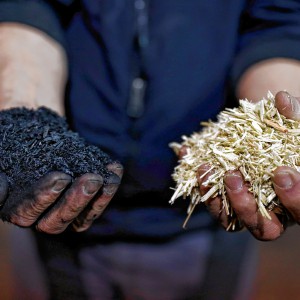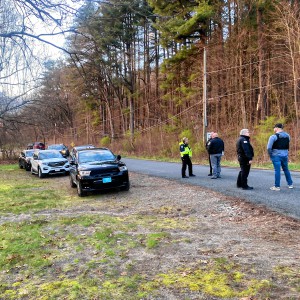Speaking of Nature: A “No Mow May” miracle: Analyzing a mystery plant
| Published: 06-06-2023 4:02 PM |
For the past couple of years there has been a big push for property owners to observe something called a “No Mow May.” The general idea (first popularized in the United Kingdom) is to postpone mowing until the end of May in order to allow flowers to bloom in greater numbers, which in turn will provide food for early-season pollinators. I have also heard of a variant called, “No Mow ‘Till Mother’s Day,” which addresses some of the drawbacks associated with a failure to mow lawns until the first of June.
Back in 2005, when I first moved into my current house, I found myself staring out across a huge area of short lawn that reminded me of a golf course. The man from whom I purchased the house had a real thing for mowing and he liked to keep the lawn tight. This was an attitude that I did not share and after mowing this massive area just a couple of times I decided that it was time to make some changes. I “let the lawn go” in certain places and today there is more of a field rather than a lawn. There are also about ten thousand fireflies that use this area every June, so I’m happy with my decision.
I still maintain quite a bit of lawn around my house, but I have always been of the “No Mow May” mindset and didn’t need an official movement to convince me to take it easy in the spring. When I do cut the grass, I keep the mower deck on its highest setting and I always steer around anything that looks interesting. Because of the odd weather that we have had this spring (warm early and definitely dry) I have been able to resist mowing some of the lawn for longer than I might have otherwise because the plants just aren’t growing that quickly. As a result, there has been a wonderful development on the west side of my house.
Growing in the grass was a plant that was clearly not just any weed. A light green color, the plant had the appearance of being almost dead due to its “droopy” appearance. Imagine a green candy cane with a somewhat wilted appearance and you’ve got the idea. The plant looked as though it was drying out and dying, but experience informed me that this is just the way this particular plant looks when it is growing. Droopy though it may have appeared, the plants were actually healthy and thriving and wherever one emerged from the lawn I steered clear.
Just when the flowers were about to open, the stems finally straightened out completely so the flowers would face the sky. The blooming of the flowers was all the reward I needed to encourage me to do this again year after year. Flattened disks of feathery soft “rays” surround a smaller central disc of golden yellow. This is the Philadelphia fleabane (Erigeron philadelphicus), or at least I think so.
What I do know is that the Erigeron genus is part of the Asteraceae Family, which consists largely of composite flowers. I’ll try to minimize all of the techno-talk here and simply say that what looks like a single flower is really a collection of many smaller flowers arranged in a pattern known as an “inflorescence.” In the case of the flowers shown in the photo, the golden center is full of smaller flowers and the pink “ray” petals surround the flowers to provide more attraction for pollinators. I actually selected a photo that accentuates this characteristic and evidence of the individual “golden” flowers can be seen on the left side of the center of the inflorescence. When the flowers finally go to seed, the seeds disperse like dandelion seeds.
What is curious about this plant is the difficulty that I had in identifying it. I am absolutely certain that the Erigeron genus is correct, but species identifiers have been difficult to nail down. Some resources mention species names that are mentioned nowhere else and the list of common names by which the species is known is long and confusing. “Daisy fleabane” has come up more than once, but it appears that this particular common name has been applied to different species so many times that a solid identification was difficult. However, I think I have done a good job with Philadelphia fleabane.
Ultimately, the human name for this plant is not nearly as important as its existence. The flowers of this plant have a “soft” feeling to them and I sometimes think of them like soap bubbles. Their color is exquisite (a pink that is as soft in its hue as the flowers are soft in their appearance) and they are growing in a community that includes ragged robin and buttercups. The tall emergent stems of all three species hold their lovely flowers up above the shorter grasses beneath them and the entire effect is one of true beauty. And it’s all because I didn’t mow.
Article continues after...
Yesterday's Most Read Articles
 Locking up carbon for good: Easthampton inventor’s CO2 removal system turns biomass into biochar
Locking up carbon for good: Easthampton inventor’s CO2 removal system turns biomass into biochar
 Northampton man will go to trial on first-degree murder charge after plea agreement talks break down
Northampton man will go to trial on first-degree murder charge after plea agreement talks break down
 Police report details grisly crime scene in Greenfield
Police report details grisly crime scene in Greenfield
 Area property deed transfers, April 25
Area property deed transfers, April 25
 Advancing water treatment: UMass startup Elateq Inc. wins state grant to deploy new technology
Advancing water treatment: UMass startup Elateq Inc. wins state grant to deploy new technology
 Super defers Amherst middle school principal pick to successor; one finalist says decision is retaliation for lawsuit
Super defers Amherst middle school principal pick to successor; one finalist says decision is retaliation for lawsuit
Bill Danielson has been a professional writer and nature photographer for 26 years. He has worked for the National Park Service, the US Forest Service, the Nature Conservancy and the Massachusetts State Parks and he currently teaches high school biology and physics. For more in formation visit his website at www.speakingofnature.com, or head over to Speaking of Nature on Facebook.
]]>

 Valley Bounty: Grass-fed animals that feed the grass: Gwydyr Farm in Southampton focuses on ‘restoring the connection between land, food and people’
Valley Bounty: Grass-fed animals that feed the grass: Gwydyr Farm in Southampton focuses on ‘restoring the connection between land, food and people’ Weekly Food Photo Contest: This week’s winner: Mary Chicoine of Easthampton
Weekly Food Photo Contest: This week’s winner: Mary Chicoine of Easthampton  Speaking of Nature: A romantic evening for two birders — To hear the wonderful sounds of the Saw-whet Owl one must go outside at night
Speaking of Nature: A romantic evening for two birders — To hear the wonderful sounds of the Saw-whet Owl one must go outside at night Speaking of Nature: Where have all the birds gone?: They’re there, and here’s a handy tool to keep track of their appearances
Speaking of Nature: Where have all the birds gone?: They’re there, and here’s a handy tool to keep track of their appearances
